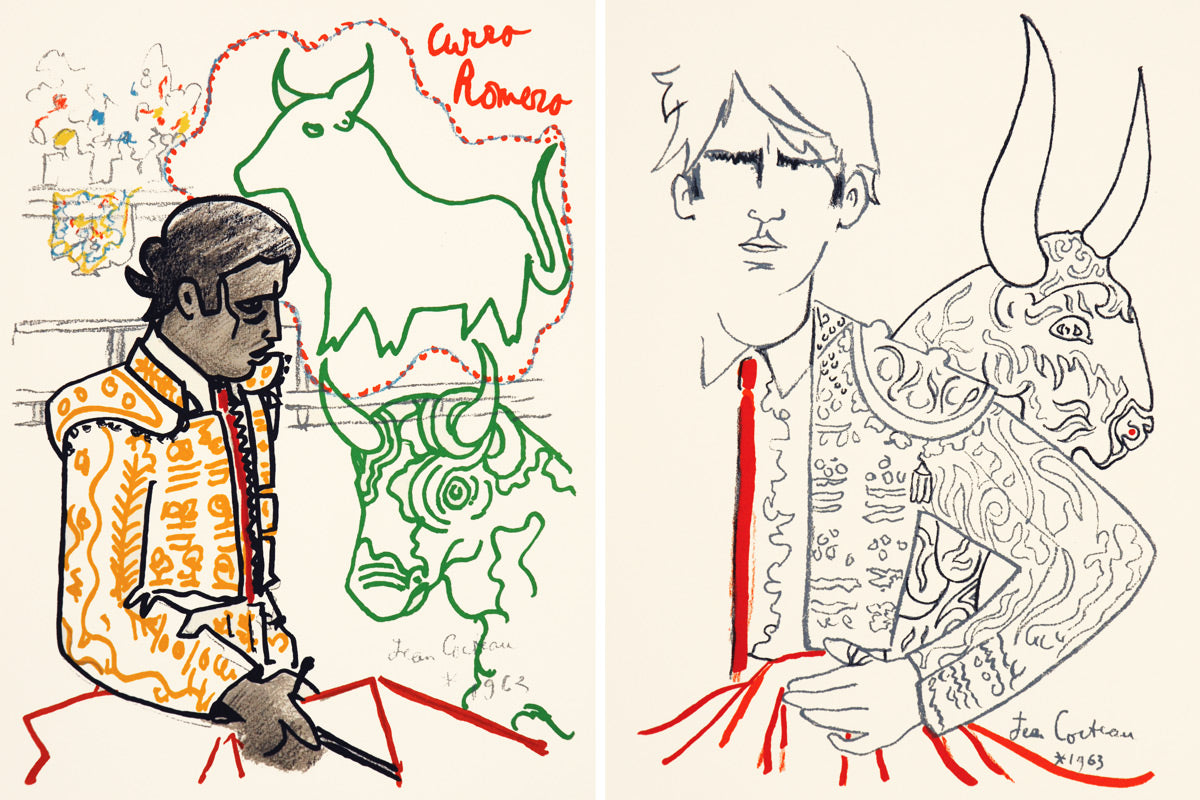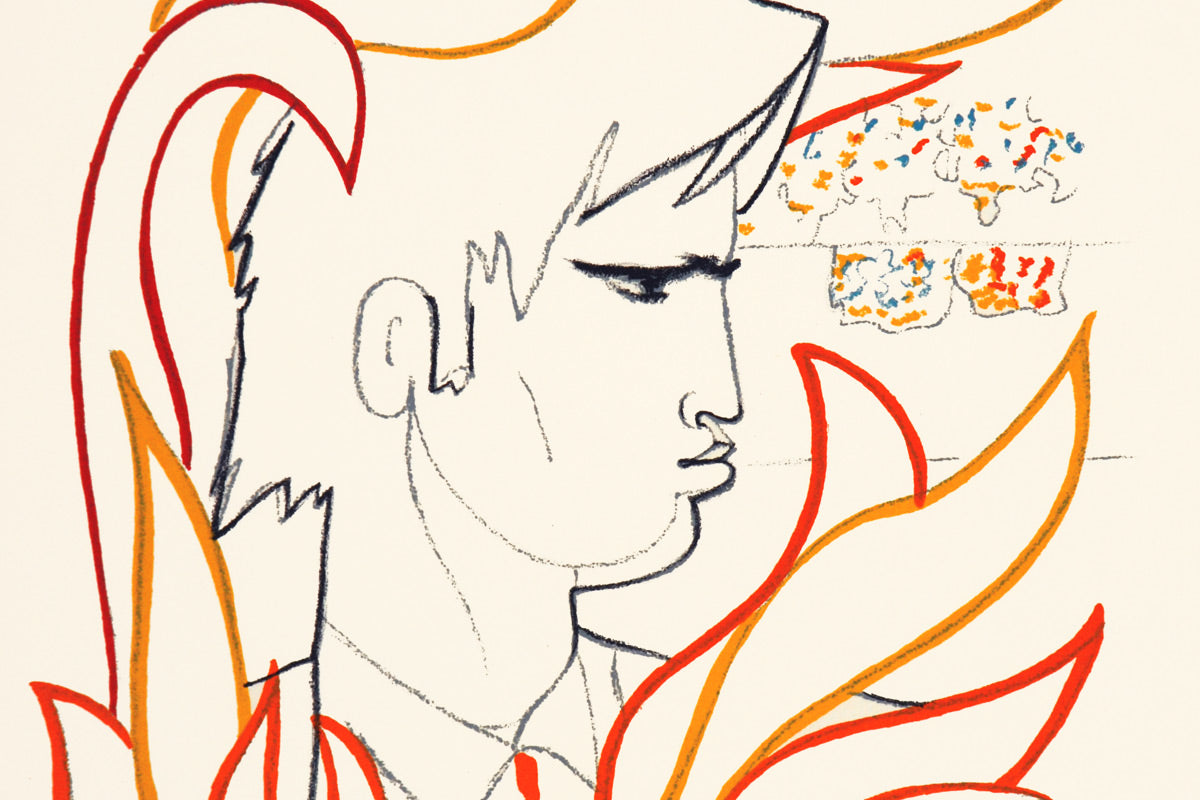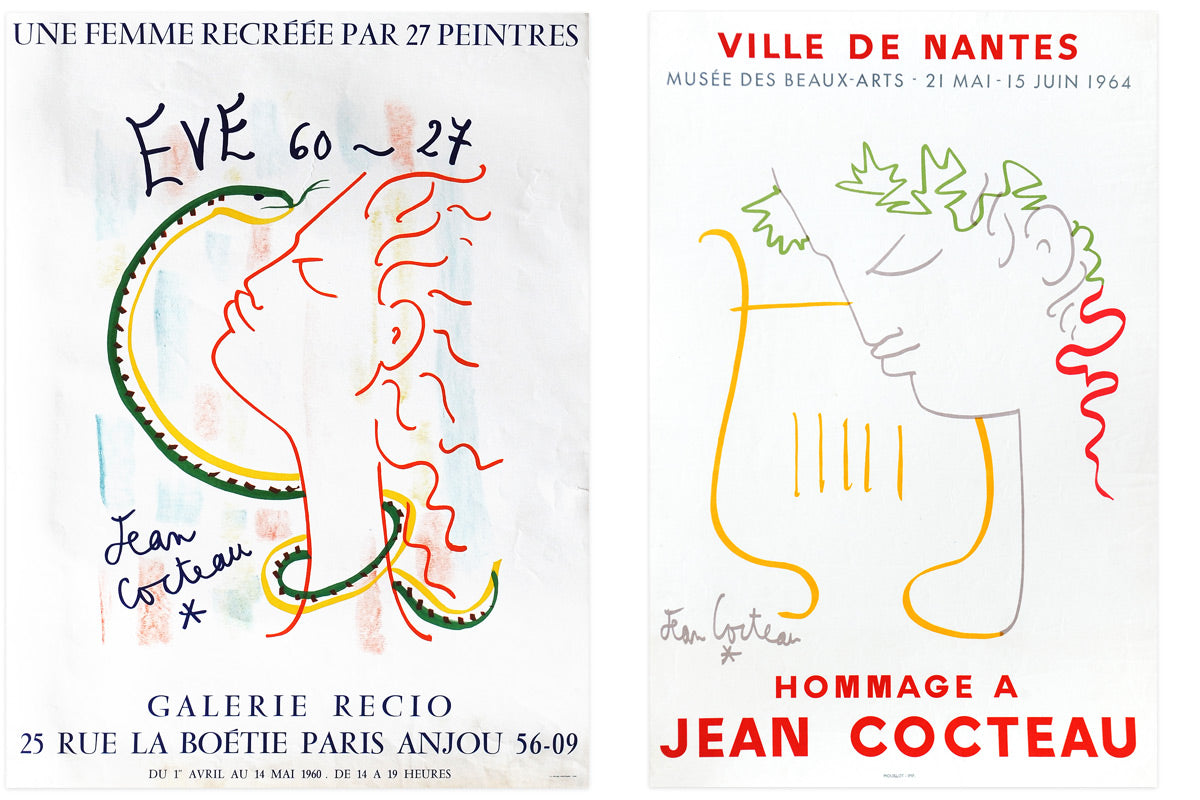Impulsive, impatient, hopelessly romantic, and - above all - a virtuoso creator, Jean Cocteau was a man who embraced life with wanton abandon. A poet, writer, artist, choreographer and film maker, there were few artistic pursuits that he left untouched in his long and colourful career.
His life was one of extreme highs and lows, as is often the case with those who sail closest to the wind. He was an artist sustained by tragedy as much as ecstasy, and he would leave his indelible mark on an extraordinary array of avant-garde projects.

 (above) surreal portrait of Cocteau; (below) two posthumous lithographic posters advertising exhibitions of Cocteau's work
(above) surreal portrait of Cocteau; (below) two posthumous lithographic posters advertising exhibitions of Cocteau's work
Cocteau was born in 1889 into a wealthy family in a small town near Paris. A difficult young boy, his childhood was fraught with unrest: Cocteau’s father killed himself when he was about 10 years old and in 1900 he was enrolled at a private school, the well respected Lycée Condorcet, only to be expelled in 1904.
In the few years Cocteau spent studying at the Lycée he befriended a pupil called Pierre Dargelos, an older schoolmate who first introduced his contemporaries to the virile world of homo-eroticism. Dargelos was a physically imposing boy, athletic, unusually well-endowed for his age (if Cocteau's later writings are to be believed), and the sexual initiations he exposed his fellow pupils to would have a deep and long-lasting influence on the artist's future works.
 erotic print from the 'Livre Blanc' suite; homo-eroticism and the artist's sexual fluidity informed a great part of Cocteau's output
erotic print from the 'Livre Blanc' suite; homo-eroticism and the artist's sexual fluidity informed a great part of Cocteau's output
After his expulsion, Cocteau ran away to Marseilles, taking temporary refuge in the red light district and fabricating a new identity for himself. His attempt to escape into the underworld was short lived, however, and he was later discovered by the local police and returned to the custody of his uncle. Then, around the age of 17 or 18, Cocteau began an affair with the actress Madeleine Carlier, who was 30 years old at the time, though she later ended the relationship.
 the bold, classical profile of a Cocteau portrait
the bold, classical profile of a Cocteau portrait
In these early years Cocteau began cultivating a Bohemian streak that, alongside his sexual ambivalence, would characterise the fullness with which he lived his life. By the late 1900s and early 1910s, he had already begun to associate himself with a host of young artists who would have an impact on his career: Edouard de Max, a popular Parisian tragedian at the time who first encouraged the young poet to write; Sergei Diaghilev, the Russian agent in charge of the Ballets Russes, at whose instigation Cocteau wrote a libretto for the exotic ballet Le Dieu Bleu; and the composer Igor Stravinsky, whom Cocteau met after he had recently completed his infamous The Rite of Spring.
 'Tête a Tête', from the 'Taureaux' suite of lithographs published in 1965 after Cocteau's death
'Tête a Tête', from the 'Taureaux' suite of lithographs published in 1965 after Cocteau's death
But perhaps no other artistic figure impressed Cocteau as much as Pablo Picasso. Almost every painting, print and sketch Cocteau made in his life, his looseness of line, his strong profile portraits, his mythological subjects, can be traced back to Picasso's influence.
Cocteau first met the artist at the start of the First World War. With the outbreak of the conflict, Cocteau volunteered to work in an ambulance service, having not been conscripted, but was arrested and returned to civilian duties in 1915 after falling in with an unruly group of soldiers. Upon his return the two young men were introduced to one another and quickly established a close friendship, Cocteau convincing Picasso to design sets for an upcoming ballet production, Parade.

 (above) three lithographs from the 'Taureaux' suite depicting matadors in bullfighting rings
(above) three lithographs from the 'Taureaux' suite depicting matadors in bullfighting rings
Directed by Diaghilev, Picasso's services were enlisted to help with the design of the sets. The French composer Erik Satie had written the music, a surreal score that, when combined with Picasso's vibrant modern staging, made for an exciting and revolutionary production. Though the Paris opening performances were disastrous, within a few years the ballet found success and Picasso and Cocteau continued to meet as friends and to discuss other potential projects.
During their time spent together, a frequent meeting place was in the arena seats of a traditional bullfight. Picasso and Cocteau shared a joint love of the macho-heroism of the sport, of its theatrics and its flamboyance. For both artists, the modern-day matador drew parallels to Ancient Greek athletes and Olympian Gods, though for Cocteau these masculine displays of strength and prowess had a more personal and intimate resonance too.

 (above) Cocteau's matadors embody the virility, athleticism, and masculine charisma he frequently wished he had possessed himself
(above) Cocteau's matadors embody the virility, athleticism, and masculine charisma he frequently wished he had possessed himself
After the end of the First World War, Cocteau helped found the publishing house Éditions de La Sirène, publishing both his own works and musical scores by Satie, Stravinsky and the group of composers known as 'Les Six'. He also made an intimate friend in the 15-year-old poet and novelist Raymond Radiguet who became a strong influence on Cocteau’s art and life.
Radiguet was not just young and talented; he was sexually promiscuous too, and having seduced Cocteau became one of the artist's most important muses. His image reappears in a number of erotic sketches and prints, portrayed alongside lusting muscular sailors and satyr-like figures cavorting in fields.

 (above) a truncated sailor from the 'Livre Blanc' series looks longingly towards the window; (below) two untitled homo-erotic prints from the 'Livre Blanc' series, originally published in 1930
(above) a truncated sailor from the 'Livre Blanc' series looks longingly towards the window; (below) two untitled homo-erotic prints from the 'Livre Blanc' series, originally published in 1930
How developed the relationship between both men became is uncertain. Some accounts suggest a 'mentor and pupil' dynamic, while others suspect their affair was secretive and sexual. Either way, it would set the impassioned and, at times, fractured tone of many of Cocteau's later liaisons. As he wrote in Le Livre Blanc, a collection of images and writings on the artist's sexuality, I am ravaged by love. Even when I am at peace, I shake with fear that this peace will come to an end, and this anxiety prevents me from taking any pleasure in it. Waiting is torture, passion is another form of torture, for fear of losing what I have...'
Tragically, Radiguet died after contracting typhoid on a trip with the artist in 1923. Distraught at the loss, Cocteau treated his ensuing depression with opium and before long was gripped by addiction. It would be over fifteen years before he could recover, during which time he completed some of his most significant written works, including the stage play Orphée, the novel Les Enfants Terribles, and a large body of poetry.
 another overtly sexualised print from the 'Livre Blanc' suite
another overtly sexualised print from the 'Livre Blanc' suite
In 1930 Cocteau produced his directorial debut, Le Sang d'un Poète ('The Blood of a Poet'), an autobiographical insight into the artist’s mind through the mythology of his central character. The film's plot revolves around a young poet damned to spend his years in the halls of the 'Hotel of Dramatic Follies' after committing the artistic crime of bringing a statue to life.
In many ways the metaphor of the Hotel captured the essential conflict at the heart of the artist's life. Creativity became for Cocteau a kind of purgatory from which there was no escape. He was hugely conflicted, deeply insecure, and constantly being drawn between his own internal competing interests in the many art forms to which he applied his hand; but these applications he could not help but indulge, often inserting himself into his art as a way of exploring his own problems through the process of creation.
 the stoic countenance of a heroic matador; critics have noted a resemblance betwen many of these portrait s and the Roman features of Cocteau's lover and collaborator, the actor Jean Marais
the stoic countenance of a heroic matador; critics have noted a resemblance betwen many of these portrait s and the Roman features of Cocteau's lover and collaborator, the actor Jean Marais
Although throughout the following decades opium took its toll on Cocteau’s ability to keep producing work, some of his most important film productions came with his revival in the 1940s with a particularly triumphant return to the screen in La Belle et la Bête starring Jean Marais as the Beast.
Marais succeeded Radiguet as Cocteau's lover and artistic muse and starred in a number of his films from the 1940s onwards. When in the 1950s Cocteau embarked on a series of graphic works, including the famous Taureaux ('Bulls') suite of lithographs depicting matadors, elements of Marais' appearance found their way into the dark, noble brows and steely gazes of Cocteau's portraits.
 Cocteau on set with Marais for the filming of 'Le Testament d’Orphée'
Cocteau on set with Marais for the filming of 'Le Testament d’Orphée'
In 1959 Cocteau directed his final film, the third part in his 'Orphic' trilogy, Le Testament d’Orphée. Starring Cocteau himself in the lead role, and with cameos from celebrated friends including Picasso, the artist Jean-Pierre Leaud, and the actor Yul Brynner, the film features an 18th century poet who, confronted with his own impending death, travels through time reviewing his past and the broader purpose of art while searching for some greater wisdom.
Cocteau died 4 years, 74 years old, in his chateau in Milly-la-Forêt. Upon hearing the news of the death of another friend, the singer Edith Piaf, with whom he had collaborated in his 1940 play Le Bel Indifférent, he collapsed after suffering a sudden and fatal heart attack.
 two posters advertising retrospectives of Cocteau's work
two posters advertising retrospectives of Cocteau's work
A master of artistic expression in a variety of forms, Jean Cocteau remains one of the brightest lights to have burned in the first half of the 20th century. His graphic work, often overlooked, offers a window into the many fantasies that inserted their way into his writing and his films and stands as a testament to his extraordinary creative vision.










